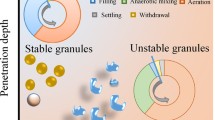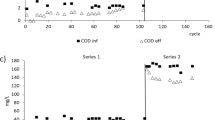Abstract
The influence of a high energy substrate, i.e. sucrose, on the granular sludge yield and the development of different types of granular sludge was investigated by using Upflow Anaerobic Sludge Bed (UASB) reactors fed with synthetic wastewater. The feed COD was a mixture of volatile fatty acids (VFA) i.e., 20, 40, and 40% of the COD as C2-, C3-, and C4-VFA, respectively. Furthermore, experiments were carried out in which 10 and 30% of the VFA COD was substituted with sucrose. The following distinctly different types of granules were observed in each testrun: in the reactor fed with solely VFA, black (B) and white (W) granules developed; in the reactor fed with a mixture of 90% VFA and 10% sucrose, three types of granules i.e., B, W, and grey (G) granules could be seen; in the reactor fed with 70% VFA and 30% sucrose, only W and G granules were found. The granular sludge yield increased proportional to the amount of sucrose COD. At steady-state performance of the reactors, specific acidogenic (SAA) and methanogenic (SMA) activity tests on these granules revealed that B granules had the highest SMA with low SAA. The W granules had very high SMA with low SAA. G granules gave the highest SAA with a considerable SMA. Measurement of coenzyme F420 revealed that B granules consist mainly of acetoclastic methanogens. The fore-mentioned tests were supplemented with analyses of the wash-out cells present in the reactor effluent and the results suggested that acidogens, if present, prevail at the granule surface. The B granules were particularly rich in Ca, Mn, and Zn minerals. The size distribution analysis showed that the granule diameter increased in the following order: B<W<G granules. The biogas bubbles tended to adhere to the B and W granules but not so strongly to the G granules.
Similar content being viewed by others
References
APHA, AWWA & WPCF (1992) Standard methods for the examination of water and wastewater, 18th edition. American Public Health Association, American Water Works Association and Water Pollution Control Federation, Washington, DC, USA
Austermann-Haun U, Seyfried CF, Kunst S, Banziger W & Rosenwinkel KH (1993) Anacrobic pretreatment in campaign industries. In: Seventh International Symposium on Anaerobic Digestion, paper submitted. Cape Town, South Africa
Barbosa RA & Sant' Anna Jr GL (1989) Treatment of raw sewage in an UASB reactor. Wat. Res. 23: 1483–1490
Beeftink HH & van den Heuvel JC (1988) Physical properties of bacterial aggregates in a continuous-flow reactor with biomass retention. In: Lettinga G, Zehnder AJB, Grotenhuis JTC & Hulshoff Pol LW (Eds) Granular Anaerobic Sludge; Microbiology and Technology. (pp 162–169) Pudoc, Wageningen, The Netherlands
Dolfing J & Mulder JW (1985) Comparison of methane production rate and coenzyme F420 content of methanogenic consortia in anaerobic granular sludge. Appl. Environ. Microbiol. 49: 1142–1145
Dubourguier HC, Buisson MN, Tissier JP, Prensier G & Albagnac G (1988a) Structural characteristics and metabolic activities of granular methanogenic sludge on a mixed defined substrate. In: Lettinga G, Zehnder AJB, Grotenhuis JTC & Hulshoff Pol LW (Eds) Granular Anaerobic Sludge; Microbiology and Technology. (pp 78–86) Pudoc, Wageningen, The Netherlands
Dubourguier HC, Prensier G & Albagnac G (1988b) Structure and microbial activities of granular anaerobic sludge. In: Lettinga G, Zehnder AJB, Grotenhuis JTC & Hulshoff Pol LW (Eds) Granular Anaerobic Study; Microbiology and Technology. (pp 18–33) Pudoc, Wageningen, The Netherlands
Fukuzaki S, Chang YJ, Nishio N & Nagai S (1991a) Characteristics of granular methanogenic sludge grown on lactate in a UASB reactor. J. Ferment. Bioeng. 72: 465–472
Fukuzaki S, Nishio N, Sakirai H & Nagai S (1991b) Characteristics of granular methanogenic granules grown on propionate in an upflow anaerobic sludge blanket (UASB) reactor. J. Ferment. Bioeng. 71: 50–57
Grotenhuis JTC, Kissel JC, Plugge CM, Stams AJM & Zehnder AJB (1991) Role of substrate concentration in particle size distribution of methanogenic granular sludge in UASB reactors. Wat. Res. 25: 21–27
Guiot SR, Gorur SS & Kennedy KJ (1988) Nutritional and environmental factors contributing to microbial aggregation during upflow anaerobic sludge bed-filter (UBF) reactor start-up. In: Hall ER & Hobson PN (Eds) Proc. Fifth International Symposium on Anaerobic Digestion. (pp 47–53) Pergamon Press, Oxford
Harada H, Endo G, Tohya Y & Momoni K (1988) High rate performance and its related characteristics of granulated sludges in UASB reactors treating various wastewaters. In: Proc. Fifth International Symposium on Anaerobic Digestion. (pp 1011–1019) Bologna, Italy
Hulshoff Pol LW (1989) The phenomenon of granulation of anaerobic sludge. Ph.D. Thesis, Wageningen Agricultural University, The Netherlands
Kosaric N, Blaszczyk R, Orphan L & Valladares J (1990) The characteristics of granules from upflow anaerobic sludge blanket reactors. Wat. Res. 24: 1473–1477
Lens P, de Beer D, Cronenberg C, Houwen F, Ottengraf S & Verstraete W (1993) Inhomogenic activity distribution in methanogenic aggregates: pH and glucose microprofiles. App. Environ. Microbiol. 59: 3803–3815
Lettinga G, de Zeeuw W, Hulshoff Pol LW, Wiegant W & Rinzema A (1985) Anaerobic wastewater treatment based on biomass retention with emphasis on the UASB-process. In: Proc. Fourth International Symposium on Anaerobic Digestion. (pp 279–302) Guangzhou, China
Morgan JW, Evison LM & Forster CF (1991) The impact of anaerobic extracellular polymers on the metabolism of granular anaerobic sludge. Environ. Technol. 12: 421–430
Ross WR (1984) The phenomenon of sludge pelletisation in the anaerobic treatment of a maize processing waste. Water S.A. 10: 197–204
Shelton DR & Tiedje JM (1984) General method for determining anaerobic biodegradation potential. Appl. Environ. Microbiol. 47: 850–857
Taya M, Aoki N & Kabayashi T (1986) Kinetic evaluation and monitoring of methanogen culture based upon fluorometry. Appl. Microbiol. Biotechnol. 23: 342–347
Tilche A & Yang X (1987) Light and scanning electron microscope observations on the granular biomass of experimental SBAF and HABR reactors. In: Lettinga G, Zehnder AJB, Grotenhuis JTC & Hulshoff Pol LW (Eds) Granular Anaerobic Sludge; Microbiology and Technology. (pp 170–178) Pudoc, Wageningen, The Netherlands
Uemura S & Harada H (1993) Microbial characteristics of methanogenic sludge consortia developed in thermophilic UASB reactors. Appl. Microbiol. Biotechnol. 39: 654–660
Valcke D & Verstraete W (1983) A practical method to estimate the acetoclastic methanogenic biomass in anaerobic sludge. J. Water Pollut. Control. Fed. 52: 720–729
Vanderhaegen B, Ysebaert B, Favere K, Van Wambeke M, Peeters T, Panic V, Vandenlangenbergh V & Verstraete W (1992) Acidogenesis in relation to in-reactor granule yield. Wat. Sci. Tech. 25: 21–30
Author information
Authors and Affiliations
Rights and permissions
About this article
Cite this article
Thaveesri, J., Daffonchio, D., Liessens, B. et al. Different types of sludge granules in UASB reactors treating acidified wastewaters. Antonie van Leeuwenhoek 68, 329–337 (1995). https://doi.org/10.1007/BF00874143
Accepted:
Issue Date:
DOI: https://doi.org/10.1007/BF00874143




